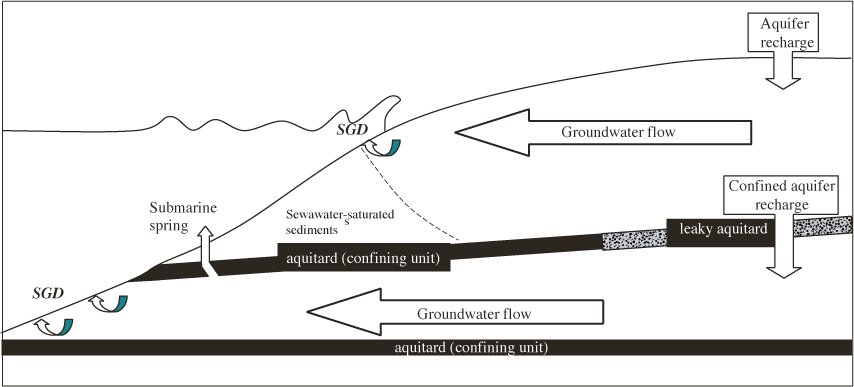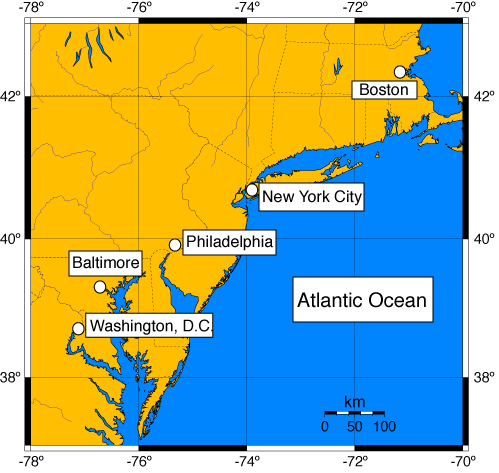


 |  |  | 5.2 Submarine Groundwater Discharge: Processes |
The term `submarine groundwater discharge' (SGD) commonly refers to the exchange of terrestrially-derived groundwater with fresh, estuarine, and coastal waters (though [62] correctly point out that SGD can also include wave pumping and other processes that involve the flushing of sediments that are saturated with surface water). Groundwater will flow within an aquifer if there is a potentiometric head between the aquifer recharge zone and the discharge zone; that is, water will flow `downhill' even when present in the pores of sedimentary material.

When an aquifer's discharge zone intersects with porous bottom sediments in the coastal zone, groundwater will flow into the coastal ocean (or estuary) as SGD (Figure 1). Unconfined aquifers will interact with the seawater-saturated sediments and create a restricted, and often diffuse, zone of SGD that is typically within 100-200 m from the coast [458]. As illustrated in Figure 1, groundwater discharge from confined aquifers can occur as springs or diffuse discharge at distances of several to hundreds of kilometers from shore.
The environmental quality of groundwater is a near-universal concern. Groundwater quality is affected by anthropogenic activities ranging from the application of agricultural pesticides and fertilizers to leaking petroleum underground storage tanks. While the immediate effect of groundwater contamination is the pollution of potable drinking water sources in the vicinity of the contamination source, groundwater flow transports dissolved constituents away from the source area. Where groundwater flow is toward the coastline, SGD can discharge these nutrients and contaminants to the coastal zone and, along with surface runoff and atmospheric deposition, provides an important non-point source discharge to estuarine and coastal ocean receiving waters.
In the eastern United States, the land bordering estuaries and the coastal zone is the site of both agricultural and industrial activities, as well as the site of large urban population centers, including Washington, D.C.; Philadelphia, PA; New York, NY; and Boston, MA (Figure 2). Industrial activities and ubiquitous petroleum underground storage tanks are a continuing threat to groundwater quality. Compounds such as polycyclic aromatic hydrocarbons (PAHs), chlorinated aliphatics (e.g., trichloroethylene), and petroleum constituents (benzene, toluene, ethylbenzene, and xylenes) and additives (e.g., MTBE) have affected both surface and confined aquifers in urban and suburban regions throughout the world.

Even rural areas experience risks to groundwater quality. Nitrate contamination of aquifers is common in agricultural areas that border estuaries [209]. Reclaimed marshland and undeveloped coastal plain areas are also widely utilized as cropland and for animal husbandry. Groundwater chemistry in aquifers underlying agricultural regions is affected by the infiltration of pesticides, fertilizers, and animal waste products from industrial farming centers.
In addition to the transport of allochthonous chemical compounds to the coastal zone, SGD also has local effects due to groundwater-surface water interactions. This `subterranean estuary' (Moore, 1999) is a particularly dynamic area where the interaction of water masses with different alkalinity and chemical composition precipitate and liberate both dissolved and solid phases. Strong redox gradients in this zone will enhance chemical reactions and can liberate both organic and inorganic compounds and stimulate biogeochemical processes that further affect groundwater chemistry [113]. Organic matter degradation can take place through a variety of pathways in the groundwater, including aerobic oxidation, sulphate reduction, and methanogenesis, further altering groundwater chemistry prior to discharge.
The interaction between seawater-saturated sediments and freshwater aquifers is not a one-way exchange. Groundwater withdrawal in the coastal zone has increased to satisfy the growing demand for drinking water and agriculture as the coastal population increases [362]; this has led to saltwater intrusion into coastal aquifers. In addition to rendering the groundwater non-potable, salt water intrusion into these aquifers causes ion exchange and other reactions to occur, which chemically alter the intruding seawater and enrich the fluids in metals and nutrients [62]. Subterranean interactions between seawater and fresh water can induce the liberation of ions adsorbed to sediment particles, including radium [274][318]. Researchers can make use of these geochemical processes to identify SGD tracers and quantify groundwater fluxes.
 |  |  | 5.2 Submarine Groundwater Discharge: Processes |